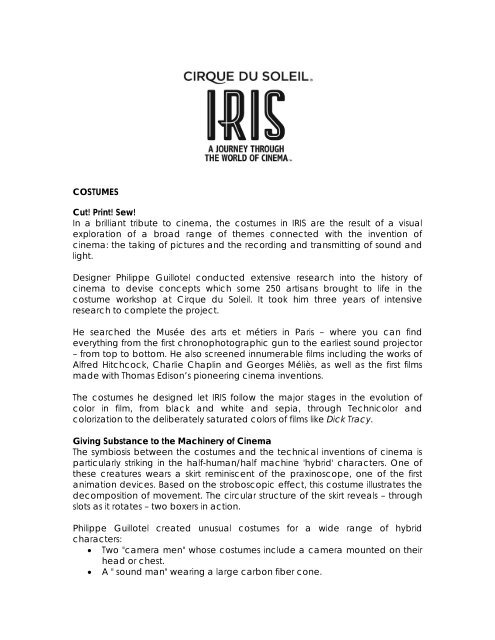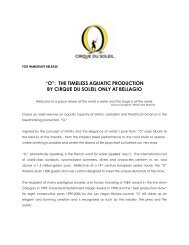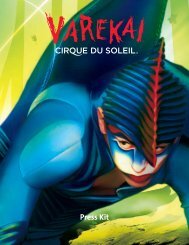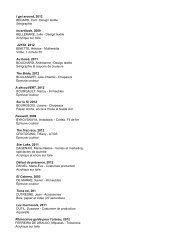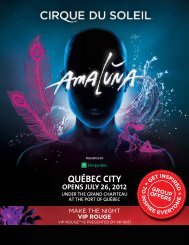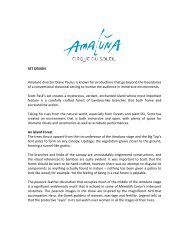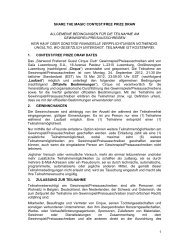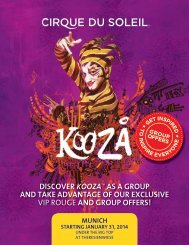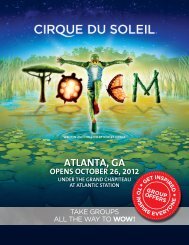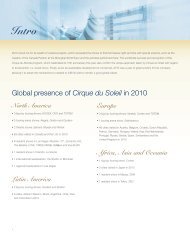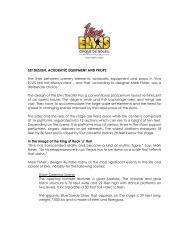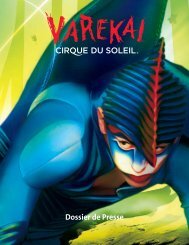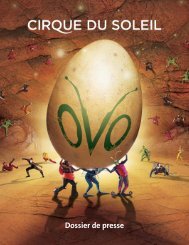COSTUMES Cut! Print! Sew! In a brilliant tribute to ... - Cirque du Soleil
COSTUMES Cut! Print! Sew! In a brilliant tribute to ... - Cirque du Soleil
COSTUMES Cut! Print! Sew! In a brilliant tribute to ... - Cirque du Soleil
Create successful ePaper yourself
Turn your PDF publications into a flip-book with our unique Google optimized e-Paper software.
<strong>COSTUMES</strong><br />
<strong>Cut</strong>! <strong>Print</strong>! <strong>Sew</strong>!<br />
<strong>In</strong> a <strong>brilliant</strong> <strong>tribute</strong> <strong>to</strong> cinema, the costumes in IRIS are the result of a visual<br />
exploration of a broad range of themes connected with the invention of<br />
cinema: the taking of pictures and the recording and transmitting of sound and<br />
light.<br />
Designer Philippe Guillotel con<strong>du</strong>cted extensive research in<strong>to</strong> the his<strong>to</strong>ry of<br />
cinema <strong>to</strong> devise concepts which some 250 artisans brought <strong>to</strong> life in the<br />
costume workshop at <strong>Cirque</strong> <strong>du</strong> <strong>Soleil</strong>. It <strong>to</strong>ok him three years of intensive<br />
research <strong>to</strong> complete the project.<br />
He searched the Musée des arts et métiers in Paris – where you can find<br />
everything from the first chronopho<strong>to</strong>graphic gun <strong>to</strong> the earliest sound projec<strong>to</strong>r<br />
– from <strong>to</strong>p <strong>to</strong> bot<strong>to</strong>m. He also screened innumerable films including the works of<br />
Alfred Hitchcock, Charlie Chaplin and Georges Méliès, as well as the first films<br />
made with Thomas Edison’s pioneering cinema inventions.<br />
The costumes he designed let IRIS follow the major stages in the evolution of<br />
color in film, from black and white and sepia, through Technicolor and<br />
colorization <strong>to</strong> the deliberately saturated colors of films like Dick Tracy.<br />
Giving Substance <strong>to</strong> the Machinery of Cinema<br />
The symbiosis between the costumes and the technical inventions of cinema is<br />
particularly striking in the half-human/half machine 'hybrid' characters. One of<br />
these creatures wears a skirt reminiscent of the praxinoscope, one of the first<br />
animation devices. Based on the stroboscopic effect, this costume illustrates the<br />
decomposition of movement. The circular structure of the skirt reveals – through<br />
slots as it rotates – two boxers in action.<br />
Philippe Guillotel created unusual costumes for a wide range of hybrid<br />
characters:<br />
• Two "camera men" whose costumes include a camera mounted on their<br />
head or chest.<br />
• A " sound man" wearing a large carbon fiber cone.
• A "screen man" whose costume conceals a 135 sq. ft. screen that comes<br />
out of his s<strong>to</strong>mach.<br />
• A character whose costume is inspired by the first sound equipment used<br />
<strong>to</strong> detect the sound of bombs in war.<br />
Some of these costumes have a useful function in the show, such as the two<br />
hybrids fitted with cameras that capture the action on stage.<br />
“I’m a devoted fan of Jules Verne's universe with all its mechanical gears and<br />
rivets,” says Philippe Guillotel. “When I see an old wood and brass camera I<br />
immediately want <strong>to</strong> make a costume. And I want everyone who sees the IRIS<br />
costumes <strong>to</strong> immediately think of one word: cinema.”<br />
Material Benefits<br />
Philippe Guillotel usually singles out five or six materials per show which he uses in<br />
every possible way. For IRIS, these included soft Lycra which can be made <strong>to</strong><br />
look woolly or glossy, silk stretch nylon, which drapes well and can be printed<br />
with reflective designs, and natural cot<strong>to</strong>ns and linens.<br />
For Philippe, the fabric is less important than the body of the artist. "You can<br />
imagine the best costume of the world, but if the dancer or acrobat doesn’t<br />
wear it well, the effect will be lost,” he says. “The IRIS dancers have magnificent<br />
bodies, and it is this beauty that I have tried <strong>to</strong> emphasize.”<br />
That is certainly the case with the acrobats whose costumes were inspired by<br />
corsets that were fashionable in the early 20th century, plus a little nod <strong>to</strong> Roman<br />
times. Even though he used a lot of leather for the corsets, Philippe relied mainly<br />
on modern fabrics and high-tech materials such as carbon fiber for their<br />
protrusions – for reasons of flexibility, comfort and lightness.<br />
Focus on Costumes<br />
• The influence of Dick Tracy is front and center in the number that pays <strong>tribute</strong><br />
<strong>to</strong> gangster movies. The artists who leap up and down the buildings from<br />
trampolines hidden in the stage floor are wearing bright red, yellow and blue<br />
tartan suits.<br />
• <strong>In</strong> the Aerial Ballet number the costumes of the bungee-jumping "diamond<br />
women" are studded with nearly one million Swarovski crystals. <strong>In</strong> the air, the<br />
artists themselves are not as visible as the brilliance of the s<strong>to</strong>nes, which give<br />
their bodies a smooth and bright look.<br />
• The costumes worn the by the Icarian Games “Kiriki” characters are an<br />
evocation of costumes in the films of Georges Méliès.<br />
• Some costumes pay <strong>tribute</strong> <strong>to</strong> various professions and crafts associated with<br />
cinema, including screenwriters, makeup artists, cinema<strong>to</strong>graphers,<br />
carpenters, decora<strong>to</strong>rs, painters, electricians and lighting designers.


